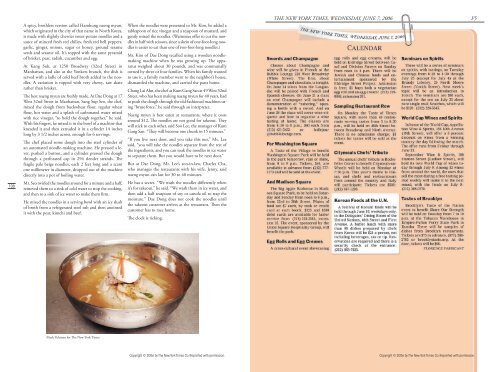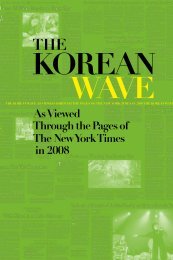The Korean Wave 2006 - Korean Cultural Service
The Korean Wave 2006 - Korean Cultural Service
The Korean Wave 2006 - Korean Cultural Service
Create successful ePaper yourself
Turn your PDF publications into a flip-book with our unique Google optimized e-Paper software.
A spicy, brothless version called Hamhung naeng myun,<br />
which originated in the city of that name in North Korea,<br />
is made with slightly chewier sweet-potato noodles and a<br />
sauce of minced fresh red chilies, fresh red bell peppers,<br />
garlic, ginger, onions, sugar or honey, ground sesame<br />
seeds and sesame oil. It’s topped with the same pyramid<br />
of brisket, pear, radish, cucumber and egg.<br />
At Kang Suh, at 1250 Broadway (32nd Street) in<br />
Manhattan, and also at the Yonkers branch, the dish is<br />
served with a ladle of cold beef broth added to the noodles.<br />
A variation is topped with very chewy, raw skate<br />
rather than brisket.<br />
<strong>The</strong> best naeng myun are freshly made. At Dae Dong at 17<br />
West 32nd Street in Manhattan, Sang Sup Seo, the chef,<br />
mixed the dough from buckwheat flour, regular wheat<br />
flour, hot water and a splash of carbonated water mixed<br />
with rice vinegar, “to hold the dough together,” he said.<br />
With his fingers, he mixed it in the bowl of a machine that<br />
kneaded it and then extruded it in a cylinder 14 inches<br />
long by 3 1/2 inches across, enough for 6 servings.<br />
<strong>The</strong> chef placed some dough into the steel cylinder of<br />
an automated noodle-making machine. He pressed a lever,<br />
pushed a button, and a cylinder pressed the dough<br />
through a perforated cap in 294 slender strands. <strong>The</strong><br />
fragile pale beige noodles, each 2 feet long and a scant<br />
one millimeter in diameter, dropped out of the machine<br />
directly into a pot of boiling water.<br />
Mr. Seo twirled the noodles around for a minute and a half,<br />
removed them to a sink of cold water to stop the cooking,<br />
and then to a sink of ice water to make them firm.<br />
He mixed the noodles in a serving bowl with an icy slush<br />
of broth from a refrigerated steel tub and then anointed<br />
it with the pear, kimchi and beef.<br />
When the noodles were presented to Mr. Kim, he added a<br />
tablespoon of rice vinegar and a teaspoon of mustard, and<br />
gently mixed the noodles. (Waitresses offer to cut the noodles<br />
in half with scissors, since a skein of one-foot-long noodles<br />
is easier to eat than one of two-foot-long noodles.)<br />
Mr. Kim of Dae Dong recalled using a wooden noodlemaking<br />
machine when he was growing up. <strong>The</strong> apparatus<br />
weighed about 30 pounds, and was communally<br />
owned by three or four families. When his family wanted<br />
to use it, a family member went to the neighbor’s house,<br />
dismantled the machine, and carried the parts home.<br />
Chang Lai Ahn, the chef at Kum Gang San at 49 West 32nd<br />
Street, who has been making naeng myun for 40 years, had<br />
to push the dough through the old-fashioned machines using<br />
“brute force,” he said through an interpreter.<br />
Naeng myun is best eaten at restaurants, where it costs<br />
around $12. <strong>The</strong> noodles are not good for takeout. <strong>The</strong>y<br />
will stick to each other, said Soo Lee, the manager of Kum<br />
Gang San. “<strong>The</strong>y will become one chunk in 15 minutes.”<br />
“If you live next door, and you take this out,” Ms. Lee<br />
said, “you will take the noodles separate from the rest of<br />
the ingredients, and you can soak the noodles in ice water<br />
to separate them. But you would have to be next door.”<br />
But at Dae Dong, Mr. Lee’s son-in-law, Charles Cha,<br />
who manages the restaurants with his wife, Jenny, said<br />
naeng myun can last for 30 to 40 minutes.<br />
He has a secret. “We wash the noodles differently when<br />
it’s for takeout,” he said. “We wash them in ice water, and<br />
then add a half teaspoon of soy or canola oil to trap the<br />
moisture.” Dae Dong does not cook the noodles until<br />
the takeout customer arrives at the restaurant. <strong>The</strong>n the<br />
customer has to race home.<br />
<strong>The</strong> clock is ticking.<br />
<strong>The</strong> New York Times, wednesday, june 7, <strong>2006</strong><br />
f5<br />
108<br />
109<br />
Mark Veltman for <strong>The</strong> New York Times<br />
Copyright © <strong>2006</strong> by <strong>The</strong> New York Times Co. Reprinted with permission.<br />
Copyright © <strong>2006</strong> by <strong>The</strong> New York Times Co. Reprinted with permission.





